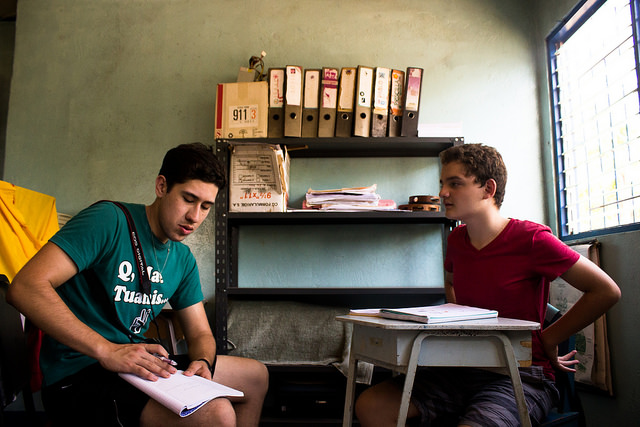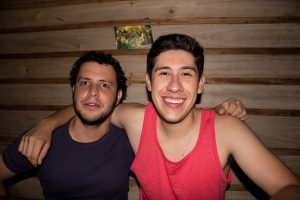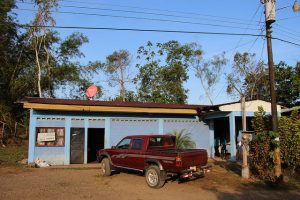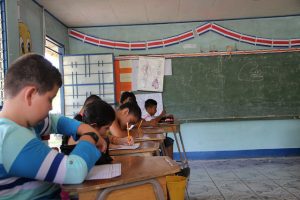 It took several attempts to remember that when referring to Costa Ricans it is properly said “Costarricenses” not “Costarriquenos”. This became a problem when I found myself being corrected by the locals, constantly. Luckily they were not offended, rather they were understanding and extremely friendly; such characteristics seemed to be quite common among Costarricenses.
It took several attempts to remember that when referring to Costa Ricans it is properly said “Costarricenses” not “Costarriquenos”. This became a problem when I found myself being corrected by the locals, constantly. Luckily they were not offended, rather they were understanding and extremely friendly; such characteristics seemed to be quite common among Costarricenses.
Of all the Costarricenses that I met I found the youth, in particular, very intriguing because their thought process about education and life was more enlightening than I would have ever expected. Going into the Global Sustainability & Cultural Immersion, Costa Rica Program I knew that I wanted to speak to the youth because the youth has a tendency to speaking the truth, or rather they are more honest and straightforward about their opinions on certain criteria like education and overall happiness. That being said, the entire trip was extremely rewarding but the visit we paid to the schools of Mastatal was by far the most informative and eye-opening experience of the program.
Interrogating Brayan

The night prior to my visit to the local public schools of Mastatal, I had the opportunity to speak to Brayan Montero, a high school Spanish teacher or a profesor de Español, at my homestay. Brayan had a lot to share about Costa Rica’s education system and love he had for el medio ambiente or Mother Nature. Born and raised in Puriscal, the closest neighboring city with a population exceeding five thousand, Brayan happily makes the weekly, two and a half hour long, and bumpy commute to Mastatal. His reasoning is simple: there is more work and hire pay in rural areas like Mastal for full time teachers, he enjoys the hospitality and tranquility of the country folk lifestyle, and he prefers being in the presence of el medio ambiente. Although Brayan made it clear that “El que no estudia es proque no quiere” or “Those who do not study are those that do not want to study” it is apparent there is no other excuse for anyone not to study in Costa Rica, regardless of whether one happens to live in rural areas like Mastatal. This is because the Costa Rican government has made a huge effort to support and fund educational systems in rural areas of the country. The value of an education in Costa Rica far outweighs any army, materialistic influence, or political dispute and that is why no child in Costa Rica, no matter how poor or far from “civilization” they are, they will always have access to an education. Brayan, like the rest of the schoolteachers of the town, were passionate about their work, as were their students passionate about learning.
La Escuela Secundaria

The following morning Brayan invited us on his fifteen-minute walk to el colegio or the local high school that had no more than thirty-five students from the neighboring barrios or towns of San Miguel and Zapaton. As we arrived at 6:30 A.M. we noticed students cramming for their Spanish final as it was the last test they had before their spring break or semana santa. The students wore light blue polo’s and khaki pants, the girls had more or less the same hairstyle that consisted of a really tightly braided ponytail, whereas the fellas spiked up their hair with pride. As the last few stragglers drove in on their motorcycles ,Brayan gave us a quick tour of the colegio, which was a humble building conveniently located in the center of town between the church and the public library. Due to time constraints I didn’t have the opportunity to speak with many of the high school students, fortunately we ended up visiting the primary and middle school later on that day.
La Escuela de Mastatal is home to thirteen students, four teachers, and one kitchen lady (Luz Milda, my homestay mom).

The primary and secondary students were bunched into one classroom and they too were equally, if not more excited, than the high school students to get on with their spring break. Amongst their excited faces I noticed one student in the corner, his name was Isaac (pictured at the top of this article). Isaac Felipe Guzman-Guzman, to be thorough. At first I assumed that Isaac was the troublemaker of the classroom, but my assumptions were proven wrong. Isaac was special and preferred working alone. He had a strange obsession with Scandinavian countries for a boy that had lived all of his life in tropical weather. Nonetheless Isaac wanted to learn as much as he could while in school and he wanted to travel afterwards, but at the end of the day he wanted to return to his hometown of Mastatal.
“Gozado”
Most everyone I met in Costa Rica, including Isaac, preferred a rural lifestyle over the city life because according to them, it was much more peaceful and life isn’t driven by money like it is in the city, rather it is meant to be gozado or enjoyed to its fullest by the simplest things like family, good food, and la naturaleza (nature). I was astonished that a sixth grader could think so wisely and for that reason I will always remember how and why Costarricenses live the way they do.
Juan M. Castañeda.
